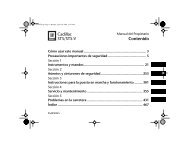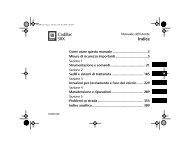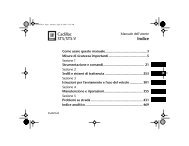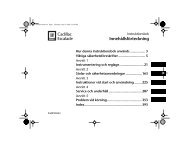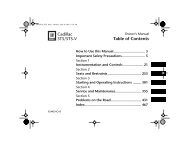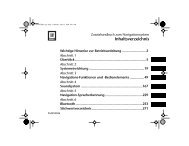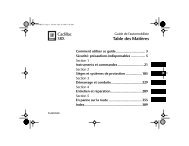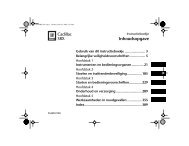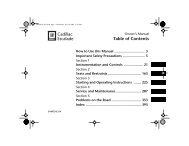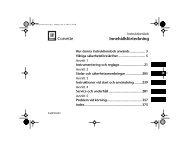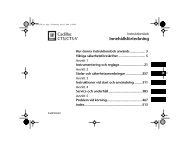Owner's Manual Cadillac BLS - IFS Europe BV
Owner's Manual Cadillac BLS - IFS Europe BV
Owner's Manual Cadillac BLS - IFS Europe BV
Create successful ePaper yourself
Turn your PDF publications into a flip-book with our unique Google optimized e-Paper software.
460_OM_MY09.book Page 230 Wednesday, April 2, 2008 10:32 AM<br />
230 Car care<br />
Engine bay<br />
The engine bay should be cleaned with an<br />
engine degreasant and rinsed with hot<br />
water. The headlights must be covered<br />
over. Do not use a pressure washer. Avoid<br />
spraying electrical components and connectors.<br />
Do not use petrol as a cleaning agent or solvent<br />
when carrying out repairs or maintenance.<br />
we recommend the use of environmentally-friendly<br />
degreasants.<br />
Waxing and polishing<br />
Do not wax a new car during the first<br />
3-4 months. In fact, there is no need to<br />
polish the car before the paintwork has<br />
started to go dull through oxidation. Other<br />
than in exceptional cases, do not use abrasive<br />
polishes containing a cutting agent on<br />
a new car. Always wash the car thoroughly<br />
before waxing or polishing.<br />
Touching up paintwork<br />
Damaged paintwork should be treated as<br />
soon as it is discovered: the longer it is left,<br />
the greater the risk of corrosion. The anticorrosion<br />
warranty does not cover corrosion<br />
resulting from untreated defects.<br />
Paintwork damage sustained in a collision is<br />
usually extensive and can only be properly<br />
restored by professionals.<br />
However, you can repair small scratches<br />
and stone chip damage yourself. The necessary<br />
tools and materials, such as primer,<br />
touch-up paint and brushes, are available<br />
for purchase. We recommend that you contact<br />
an authorised <strong>Cadillac</strong> workshop.<br />
In the case of minor flaws in the paintwork,<br />
where the metal has not been exposed and<br />
an undamaged layer of paint remains,<br />
touch-up paint can usually be applied<br />
directly, after any dirt has been scraped<br />
away using a pointed knife.<br />
If corrosion has already set in, such as the<br />
result of stone-chip damage, use a pointed<br />
knife to scrape off all surface rust. If possible,<br />
the damaged area should be taken<br />
back to the bare metal. The metal should<br />
then be primed with two thin coats of primer<br />
applied by brush.<br />
After the primer has dried, apply several thin<br />
layers of topcoat until the surface of the<br />
repaired area is flush with the surrounding<br />
paintwork.<br />
Stir both primer and touch-up paint<br />
thoroughly before use and allow each<br />
coat to dry before applying the next.<br />
Two-coat enamel<br />
As the name implies, two-coat enamel is<br />
applied in two operations. The first coat, the<br />
base colour, contains pigment, metal flakes<br />
and binder. The second coat consists of a<br />
clear enamel, which give the paintwork its<br />
final gloss and protects the base from moisture<br />
and environmental contaminants.<br />
Touch up stone chip damage as follows:<br />
Thoroughly clean the damaged area, and<br />
then apply the primer, base colour and<br />
finally, the clear enamel. To achieve the<br />
best finish, apply two or three coats of<br />
primer.




